
PIONEERING FILIPINO BOXERS TAKE THE SPOTLIGHT ON FIL-AM HISTORY MONTH (PART I)
By Dong Secuya
PhilBoxing.com
Thu, 16 Oct 2025
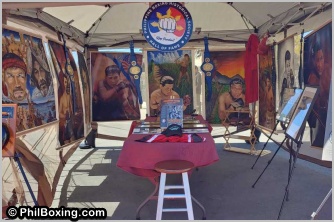
SAN FRANCISCO – October marks Filipino American History Month (FAHM) in the United States, a nationwide celebration honoring the rich cultural contributions of Filipino Americans. The month was chosen for its historical significance: on October 18, 1587, Filipino sailors aboard the Spanish galleon Nuestra Señora de Esperanza set foot in Morro Bay, California, marking the earliest recorded Filipino presence in what is now the U.S.
FAHM was officially recognized by the U.S. Congress in 1991 and has been celebrated annually since 1992, particularly in states with large Filipino-American communities such as California, Hawaii, Nevada, and New York. These month-long festivities spotlight Filipino cuisine, music, dance, history, and heritage—through parades, performances, exhibits, and educational events.
Among the most vibrant celebrations are those in Carson, Historic Filipinotown in Los Angeles, and SOMA Pilipinas in San Francisco, as well as in Daly City, home to one of the largest Filipino populations in the Bay Area.
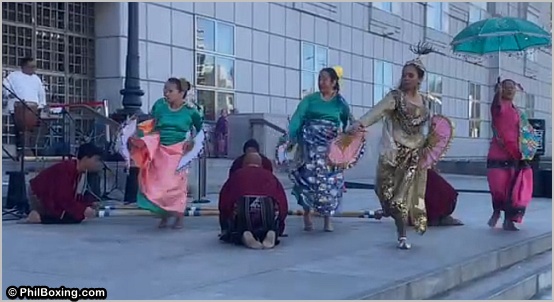
The famous LIKHA Pilipino Folk Ensemble performs one of their highly applauded numbers.
On Saturday, October 11, one such celebration was held at Fulton Plaza, nestled between the Asian Art Museum and the San Francisco Public Library (SFPL), with the Pioneer Monument standing at its center. Organized by SFPL, the event—titled "Bangon Kabayan: Pistahan sa Fulton"—was a festive cultural showcase featuring the world-touring LIKHA Pilipino Folk Ensemble, who captivated the crowd with graceful performances of traditional dances such as Tinikling and Singkil.
The program also included Filipino martial arts and boxing demonstrations, along with a dynamic musical set by Power Struggle. Booths lined the plaza, offering Filipino books, crafts, trinkets, and novelties.
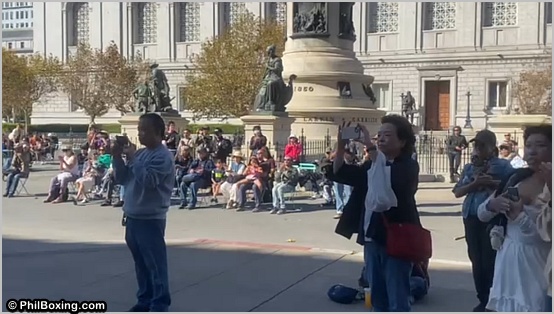
A portion of the crowd who watches the performance at Fulton Plaza on a windy Saturday afternoon in San Francisco.
One understated yet deeply significant booth belonged to the Philippine Boxing Historical Society. It featured a humble yet moving exhibit of boxing memorabilia, vintage news clippings, and portraits of legendary Filipino fighters. Though modest in scale, the exhibit echoed a powerful narrative about the Filipino-American experience—especially poignant given the location, in the heart of San Francisco, the city where the first Filipino boxers set foot in the U.S. ring.
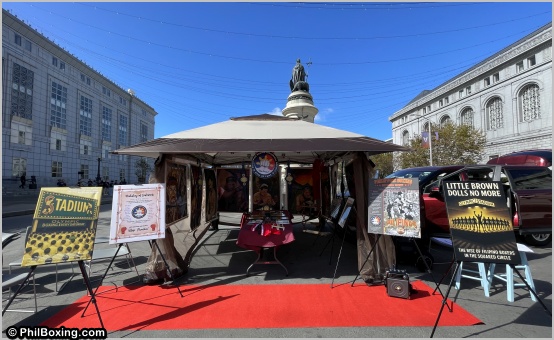
The Philippine Boxing Historical Society booth.
The Origins of Boxing in the Philippines
The introduction of boxing to the Philippines cannot be separated from the complex history of colonization.
In April 1898, the United States declared war on Spain, ostensibly to support Cuban independence. But behind that motive were strategic and imperial interests. In May 1898, the U.S. launched a surprise naval assault on the Spanish fleet in Manila Bay, at a time when the Philippines had already been under Spanish rule since 1565.
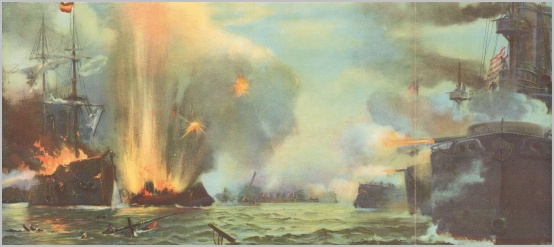
The Battle of Manila Bay (1898). Painting by James Gale Tyler.
By August 1898, Spain was defeated—thanks not only to American firepower but also to the resistance of Filipino revolutionaries, led by Emilio Aguinaldo, who had long fought for independence. But instead of recognizing Philippine sovereignty, the U.S. negotiated directly with Spain in the Treaty of Paris (December 1898), acquiring the Philippines, Guam, and Puerto Rico for $20 million. Cuba was nominally granted independence, though the U.S. maintained military control there for several years.
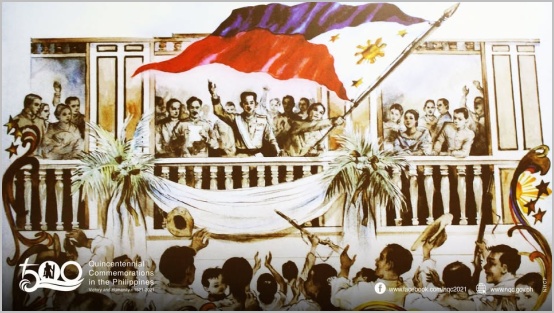
Depiction of Emilio Aguinaldo's declaration of Philippine independence on June 12, 1898 in Kawit, Cavite. Photo courtesy of National Quincentennial Committee.
For the Filipinos, this was a bitter betrayal. Having declared independence on June 12, 1898, they found themselves once again under colonial rule—this time by a new power. What followed was the Philippine-American War (1899–1902), a brutal and bloody conflict that claimed an estimated 4,200 American soldiers, over 20,000 Filipino combatants, and more than 200,000 Filipino civilians. President Theodore Roosevelt declared the war officially over on July 4, 1902, though resistance, especially in the southern Muslim regions, continued for years.
American colonial rule over the Philippines would last until July 4, 1946, when independence was finally granted after World War II.
From Warships to Steamships: A Route to the Ring
Following the war, the U.S. established a naval and commercial sea route between San Francisco and Manila, via Honolulu, to support military and trade operations. By 1902, this route expanded to include Seattle, Cebu, and Iloilo, evolving into a regular transpacific shipping line.
It was during this period of occupation and exchange that American soldiers and officials introduced boxing to the local population in the Philippines. Filipino youth, intrigued and eager to learn, quickly picked up the sport. Enterprising American promoters set up boxing venues in Manila that became a regular entertainment outlet. Some of these fighters became skilled enough to be brought to the United States—especially to San Francisco, the West Coast's principal port city and cultural hub—where they would test their skills in American rings. Some Filipino sailors working on these ships also turned to boxing and fought in the US as well.
This laid the foundation for what would become a rich legacy: Filipino boxers crossing the Pacific to make their mark in U.S. boxing history—a journey that began not in glitzy arenas, but in the gritty gyms of San Francisco, amid the backdrop of empire, resistance, and cultural exchange.
Click here for Part II
Click here to view a list of other articles written by Dong Secuya.
Recent PhilBoxing.com In-House articles:
Luisito “Lindol” Espinosa and the Art of Playing Boxing
By Emmanuel Rivera, RRT, Tue, 11 Nov 2025Island Time: Xander Zayas-Abass Baraou Junior Middleweight World Title Unification Showdown Set For January 31 at Coliseo de Puerto Rico in San Juan
Tue, 11 Nov 2025Kyle Lowry becomes the 12th player with 20 seasons or more in the NBA history
By Gabriel F. Cordero, Tue, 11 Nov 2025Donaire awaits WBA decision
By Joaquin Henson, Mon, 10 Nov 2025Joel “lethal” Lewis inks Managerial deal with Dragon Fire Boxing
Mon, 10 Nov 2025Meet Jayr Raquinel: The Filipino Sensation Taking the Super Flyweight Division by Storm
By Carlos Costa, Mon, 10 Nov 2025NONITO DONAIRE HOPES TO BECOME TO BECOME WORLD CHAMPION AGAIN
By Maloney L. Samaco, Sun, 09 Nov 2025Astrobio loses by TKO in 7th round
By Lito delos Reyes, Sun, 09 Nov 2025UNDEFEATED KNOCKOUT MONSTER VERGIL ORTIZ JR. DESTROYS ERICKSON LUBIN IN SECOND-ROUND
Sun, 09 Nov 2025Manny Pacquiao Arrives in LA to Oversee Son Jimuel's Highly Anticipated Pro Debut
By Dong Secuya, Sun, 09 Nov 2025Robert Racasa Shines for the Philippines on First Day of World Memory Championships
By Marlon Bernardino, Sun, 09 Nov 2025P20k for 42k winners in 3rd SDSPPO
By Lito delos Reyes, Sun, 09 Nov 2025Weights Set for Tomorrow’s Sanman Boxing Show in General Santos City
Sat, 08 Nov 2025Vergil Ortiz vs. Erickson Lubin: Can Lubin Tip the Ortiz/Ennis Apple Cart?
By Chris Carlson, Sat, 08 Nov 2025Gibbons’ ‘Thrilla’ regrets
By Joaquin Henson, Sat, 08 Nov 2025






